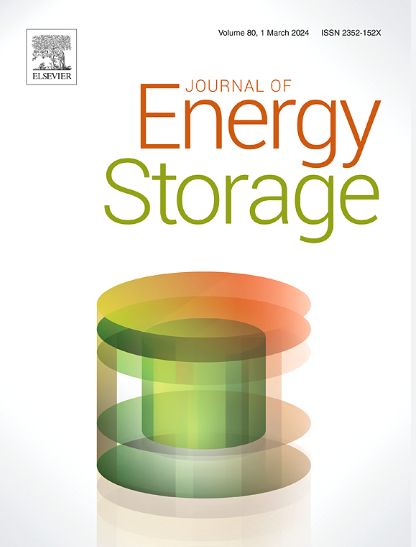碳包覆铋-氧化锌异质结微球作为锂离子电池负极材料
IF 8.9
2区 工程技术
Q1 ENERGY & FUELS
引用次数: 0
摘要
铋具有较高的理论容量,是下一代储能系统中很有前途的负极材料。然而,由于循环过程中体积变化大,结构不稳定严重,阻碍了其实际应用。从基于转换/合金的阳极设计策略中获得灵感,开发了分层微/纳米结构Bi/ZnO@C复合材料,以减轻快速容量衰退并提高电化学性能。优化后的Bi/ZnO@C阳极表现出出色的可逆性和循环稳定性,在0.1 A g−1下循环180次后,其重量和体积容量分别为797 mAh g−1和1546 mAh cm−3,在1.0 A g−1下循环1000次后,其容量保持在379 mAh g−1,超过了传统的Bi基阳极的性能。此外,与LiCoO2阴极配对的全电池结构实现了829 Wh L−1的高能量密度。这种优异的性能归功于Bi和ZnO纳米颗粒在碳微球基体中的均匀分散,形成了有益的异质界面和缺陷结构。这些特征有效地适应(去)锂化引起的应力,保持连续的离子/电子传递途径,促进快速离子和电荷转移。非原位表征结合密度泛函理论(DFT)模拟证实了Bi/ZnO@C电极的Li+吸附能力增强,反应动力学加速,电荷转移阻力降低,结构完整性提高。本文章由计算机程序翻译,如有差异,请以英文原文为准。
Carbon-coated bismuth–zinc oxide heterojunction microspheres as anode materials for lithium-ion batteries
Bismuth is a promising anode material for next-generation energy storage systems due to its high theoretical volumetric capacity. However, its practical application is hindered by severe structural instability arising from large volume changes during cycling. Drawing inspiration from conversion/alloying-based anode design strategies, hierarchical micro/nano-structured Bi/ZnO@C composites is developed to mitigate rapid capacity fading and enhance electrochemical performance. The optimized Bi/ZnO@C anode exhibits outstanding reversibility and cycling stability, delivering high gravimetric and volumetric capacities of 797 mAh g−1 and 1546 mAh cm−3, respectively, after 180 cycles at 0.1 A g−1, and retaining 379 mAh g−1 after 1000 cycles at 1.0 A g−1—surpassing the performance of conventional Bi-based anodes. Furthermore, a full-cell configuration paired with a LiCoO2 cathode achieves a high energy density of 829 Wh L−1. This exceptional performance is attributed to the uniform dispersion of Bi and ZnO nanoparticles within a carbon microsphere matrix, which forms beneficial heterointerfaces and defect structures. These features effectively accommodate (de)lithiation-induced stress, preserve continuous ion/electron transport pathways, and promote rapid ion and charge transfer. Ex situ characterizations combined with density functional theory (DFT) simulations confirm enhanced Li+ adsorption capability, accelerated reaction kinetics, reduced charge-transfer resistance, and improved structural integrity of the Bi/ZnO@C electrode.
求助全文
通过发布文献求助,成功后即可免费获取论文全文。
去求助
来源期刊

Journal of energy storage
Energy-Renewable Energy, Sustainability and the Environment
CiteScore
11.80
自引率
24.50%
发文量
2262
审稿时长
69 days
期刊介绍:
Journal of energy storage focusses on all aspects of energy storage, in particular systems integration, electric grid integration, modelling and analysis, novel energy storage technologies, sizing and management strategies, business models for operation of storage systems and energy storage developments worldwide.
 求助内容:
求助内容: 应助结果提醒方式:
应助结果提醒方式:


